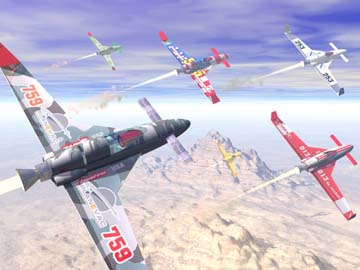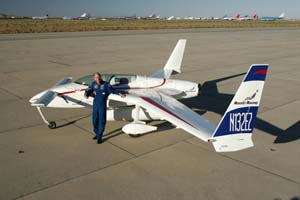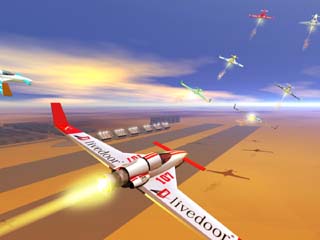pop up description layer
HOME
Cryptozoology UFO Mysteries Aviation Space & Time Dinosaurs Geology Archaeology Exploration 7 Wonders Surprising Science Troubled History Library Laboratory Attic Theater Store Index/Site Map Cyclorama
Search the Site: |
|
Is the World Ready for Rocket Racing? Rocky gunned his engine and a twenty foot long stream of fire roared out from behind his racer as he came out of the last curve. He could take Buzz on the next turn if he was careful. The rocket engine's acceleration pressed Rocky back into the seat like some giant, invisible hand as the ground below shot by at the dizzying speed of three-hundred miles per hour. If he was going to win the race he knew he would have to make his move soon. They were on the last lap... This might sound like a script from some George Lucas movie or perhaps part of a sales pitch for a new video game. It isn't either. What it maybe, if two entrepreneurs have their way, is a new sport called rocket racing. "For me, it is a remembrance of sort of 'Star Wars' pod racing," said one of the inventors, Dr. Peter H. Diamandis, referring to the rocket race portrayed in 1999's "Star Wars: Episode I -- The Phantom Menace." Diamandis and Granger Whitelaw are co-founders of the Rocket Racing League. The league was founded to encourage the sport which involves small, piloted rocket planes which will compete by racing through the heavens. If the inventors have their way, the first races could start as early as 2007.
Rocket races will operate much like auto races, with the exception that the "track" is up in the sky. Courses are expected to be approximately two miles long, one mile wide, and about 5,000 feet high, running perpendicularly to spectators. The rocket planes, called X-Racers, will take off from a runway both in a staggered fashion and side-by side and fly a course based on the design of a Grand Prix competition, with long straight-aways, vertical ascents, and deep banks. Each pilot will follow his or her own virtual "tunnel" or "track" of space through which to fly, safely separated from their competitors by a few hundred feet. Highly skilled X-Racer pilots will employ state-of-the-art differential GPS technology to ensure minimal chances of physical contact between the racers. Upon take off, onlookers will easily follow the race as the rocket planes remain in view and sport 20-foot rocket plumes. Fans can also track their favorite pilots' progress via large screen televisions and hand-held GPS tracking devices using WiFi to stream video of the cockpit, live "on-track" shots, "side by side" views and wing angle views. Fans at home will be treated to a three-dimensional course where the "tracks" pilots are following can be seen. Special effects for lap completions, barrier violations and penalties will also be a part of the show. So far only one prototype rocket racer has been created, but it's estimated that the X-Racers will cost less than $1 million to build. The engines will use a liquid oxygen/kerosene fuel mix, calculated to last for four minutes in continuous use. Pilots will have to shut down their engines repeatedly during the race and then glide, only restarting their engines to pass opponents. A typical race is expected to last for about an hour. The idea of rocket racers harkens back to the golden era of aviation when small, high speed planes competed on a small circuit outlined with pylons. Such races were popular throughout the United States many years ago, but currently are only held in Reno, Nevada, one a year.
The RRL plans to host a variety of races as it grows and each race will result in points awarded to its top finishers and qualifiers. Timed qualifying rounds can be incorporated into the races, comparable to the 24-hour Le Mans race. Will rocket racing catch on? Its co-inventor seems to think so. "The Rocket Racing League will inspire people of all ages to once again look up into the sky to find inspiration and excitement," said Diamandis. "New aerospace technologies coupled with the spirit of competition will not only extend the boundaries of entertainment, but continue the public's appetite for space ignited a year ago when the Ansari X PRIZE was awarded." Update: The Rocket Racing League hoped to get the first races in the air by 2008 or 2011. However, financial difficulties have delayed the start of this sport. As of 2013 the Rocket Racing League continues to develop flyers and plans for racing in the future. See their website at http://www.rocketracingleague.com/ Copyright Lee Krystek, 2005. All Rights Reserved |
|
Helpful Links |
|
|






